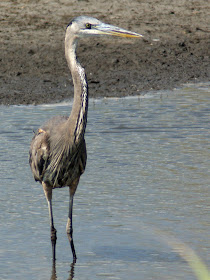.
Although most of Shovelers Pond was dry, the channel that circumscribes it contained a fair amount of water and this was busy with birds. As the vegetation along the sides of the road had recently been cut back, it was also easier to see the channel than it had been on our previous couple of visits. Patches of Evening Primrose and other wildflowers added touches of bright colors to the more muted browns, yellows and greens of the various grasses and reeds.There are many fewer alligators at Anahuac than there were before Ike but we spotted a few.
The trees and posts along the road water were busy with a good selection of common birds, including Great-tailed Grackles, Red-winged Blackbirds, Eastern Kingbirds and Turkey Vultures (below).
There were other smaller birds that I didn't manage to photograph - Dickcissels and Savannah and Seaside Sparrows - and the water had numerous Common Moorhens.
However, the main reason to visit the pond at this time of the year is to see wading birds, shorebirds and rails and so this is what we concentrated on looking for.
Green Herons were everywhere. We must have seen half-a-dozen on each circuit of the pond.
Large waders were less visible but we saw several Great Egrets as well as this Great Blue Heron.
A young Black-crowned Night Heron stood motionless as we passed by.
Black-necked Stilts were much more active and some were squabbling, presumably over territory. We were amazed to see one keep jumping up and landing on top of another. As you can see from the photo below, it would pin the other's head head to the ground with its feet an then peck hard at its back. Ouch!
Least Bitterns and rails are usually difficult to watch because they keep close to the water's edge and disappear into the reeds and grasses if they sense the slightest danger. On this trip, though, the channel was largely dry with only a trickle of water running down its center. So the birds had to venture further into the open and were much easier to see.
Least Bitterns, one of our target species, appeared at several points along the route and we spent a long time watching them. They appear quite substantial when seen in profile.
But when seen from the front, they are surprisingly thin.
Clapper and King Rails are significantly bigger and more striking.
In most parts of the country it is comparatively easy to tell these two rail species apart but on the Gulf Coast they are often indistinguishable from each other. All of the ones I saw looked like King Rails but some or all of them may just as well have been Clappers.
We also saw three or four Soras, much smaller and easier to identify rails.
As we reached the end of our final circuit of the pond I complained to Dee that, although we had had wonderful looks at some good birds, we had not managed to see any Purple Gallinules, one of our favorite birds. Thirty seconds later one appeared by the waters edge and stayed in view just long enough for me to grab a single photo through the car window.
The Gallinule provided the perfect ending to what had been one of our most enjoyable birding weekends ever.
.

















Nice capture on herons!
ReplyDelete